- Home
- Trout
When do Trout Spawn?
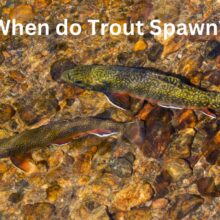
Fishing for trout is a popular pastime for many anglers around the world, but it’s important to understand when the trout spawn to ensure that we’re not disrupting their natural breeding process.
Knowing when trout spawn can also help anglers plan their fishing trips more effectively. In this article, we will explore when trout spawn, the signs of trout spawning, and the importance of protecting trout spawning sites.
Understanding the Spawning Process
Trout spawning is the process by which trout reproduce and create the next generation of fish. It occurs when male and female trout release their eggs and sperm into the water, which then fertilizes the eggs.
Trout spawning typically occurs during the fall and winter months, depending on the species and the location.
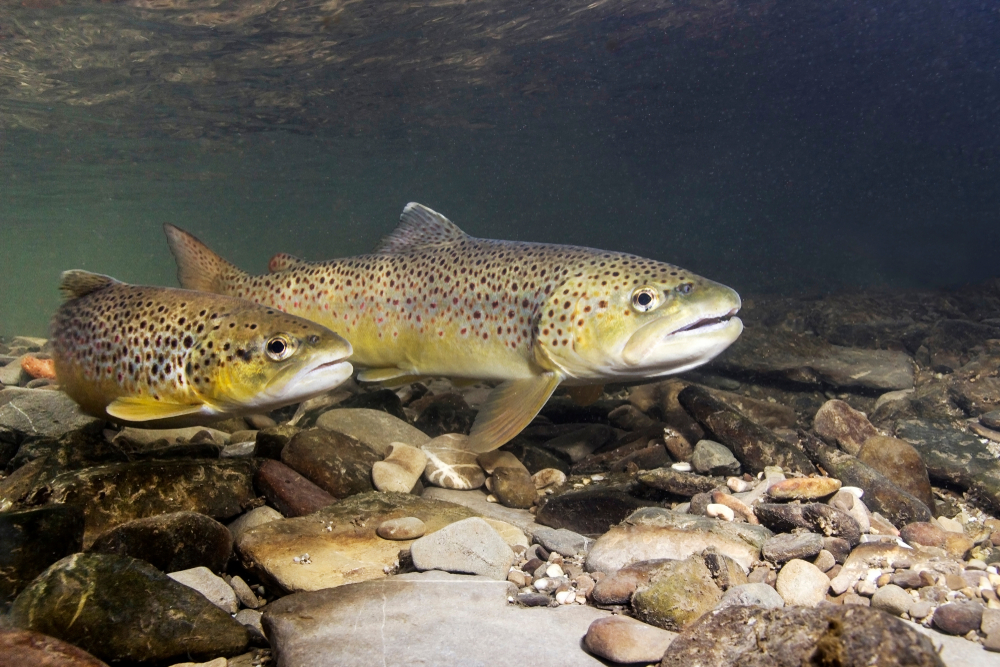
There are a number of factors that influence the timing of trout spawning, including water temperature and daylight length. As water temperatures begin to cool in the fall, male trout begin to develop small hooks on their jaws and females begin to develop eggs.
The spawning season typically lasts for several weeks, during which time the trout will mate and lay their eggs.
During the spawning process, trout will typically move to specific areas of their habitat, such as shallow riffles in streams or gravel beds in rivers, to lay their eggs. These areas provide the necessary conditions for the eggs to develop and hatch into young trout.
Understanding the trout spawning season and the behaviors associated with it is crucial for anglers to ensure that they are not interfering with the natural breeding process of the fish.
It is also important for conservationists to monitor the spawning habits of trout in order to protect their habitats and ensure the health of local fish populations.
Signs of Trout Spawning
During the trout spawning season, there are several physical changes and behaviors that can be observed in the fish. Some of the signs of trout spawning include:
- Coloration changes – Male trout often become more colorful during spawning season, developing brighter and more vibrant hues in order to attract females.
- Hooked jaws – Male trout develop small hooks on their jaws, which are used to hold onto females during the spawning process.
- Nesting behavior – Trout will often create nests, or “redds”, in shallow gravel beds or riffles in streams and rivers. These nests are used to lay and fertilize the eggs.
- Aggressive behavior – Male trout become more territorial and aggressive during spawning season, often chasing away other fish from their nesting sites.
- Mating behavior – Trout will pair up and engage in a spawning dance, where the female will lay her eggs while the male fertilizes them with his sperm.
Observing these behaviors and physical changes can provide valuable insights into the trout spawning process, but it’s important to remember to not disturb the fish during this crucial time in their life cycle.
When Do Trout Spawn?
The timing of trout spawning season can vary depending on the species of trout and the location. Generally, the spawning season for most trout species occurs during the winter and spring months.
In some areas, trout may begin to spawn as early as December, while in other areas, spawning may not begin until March. Water temperature and daylight length are two of the most important factors that influence the timing of trout spawning.
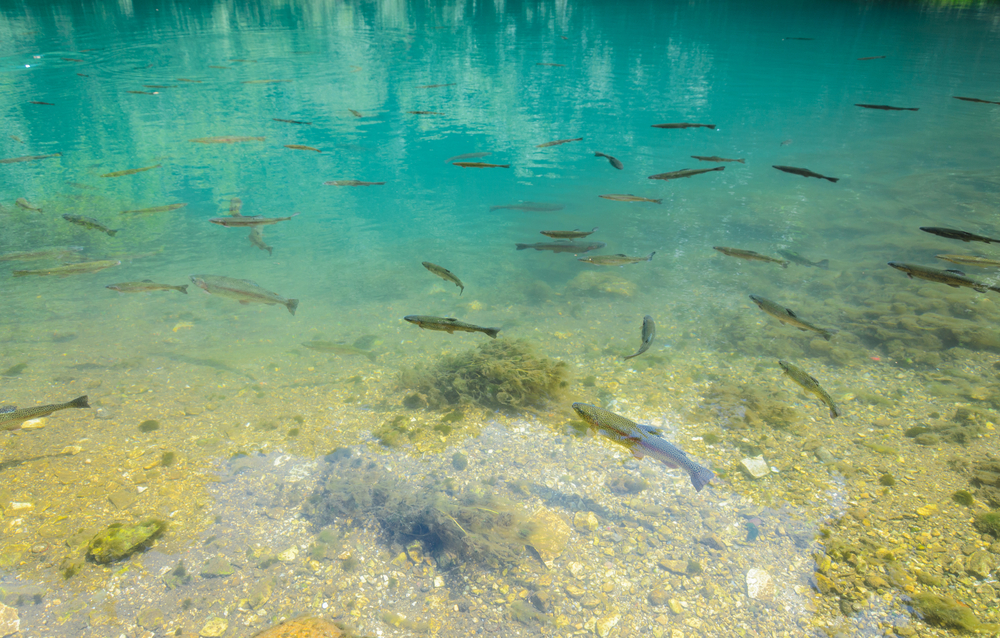
When water temperatures begin to cool in the fall, typically below 50°F (10°C), it triggers the hormonal changes in trout that prepare them for spawning.
In addition to water temperature, the length of daylight also plays a role in triggering the spawning process. As the days get shorter in the fall, it signals to the trout that it is time to begin the spawning process.
The spawning season for trout can last for several weeks, during which time the fish will mate and lay their eggs. It’s important for anglers to be aware of the timing of trout spawning season in their area, so they can avoid disturbing the fish during this crucial time in their life cycle.
Where Do Trout Spawn?
Trout will typically spawn in specific areas of their habitat, such as streams and rivers. These areas provide the necessary conditions for the eggs to develop and hatch into young trout. Some of the common spawning sites for trout include:
- Gravel beds: Trout will often lay their eggs in gravel beds in streams and rivers, where the eggs can be protected from predators and receive adequate oxygen and water flow.
- Riffles: Shallow, rocky areas of streams and rivers with a fast current, known as riffles, provide ideal spawning habitat for trout.
- Springs: Spring-fed streams provide a consistent flow of clean, cool water that is ideal for trout spawning.
- Tributaries: Small tributaries that feed into larger rivers and streams can also provide good spawning habitat for trout.
It’s important to note that trout will typically return to the same spawning sites year after year, so protecting these areas is crucial for the long-term health of the fish population.
Disturbing spawning sites during the spawning season can result in damage to the eggs and disrupt the natural breeding process of the fish.
The Importance of Protecting Trout Spawning Sites
Protecting trout spawning sites is crucial for the long-term health and sustainability of trout populations. These areas are vital for the natural breeding process of the fish and disrupting the spawning process can have serious consequences for the future of the species.
There are several ways that we can protect trout spawning sites, including:
- Reducing pollution: Pollution from sources such as agriculture, industry, and urban runoff can have a negative impact on water quality, which can harm trout and their spawning sites. Reducing pollution through proper waste management and conservation practices can help protect spawning habitats.
- Regulating fishing: It’s important for anglers to be aware of the timing of trout spawning season in their area and to avoid fishing in spawning habitats during this time. Additionally, implementing catch-and-release practices can help ensure that the fish are able to complete the spawning process and contribute to the next generation of trout.
- Habitat restoration: Restoring degraded spawning habitats, such as gravel beds and riffles, can help improve the health and productivity of trout populations. This can include measures such as adding gravel or boulders to streams and rivers to create better spawning habitat.
By protecting trout spawning sites, we can help ensure the long-term health and sustainability of these important fish populations. It’s important for anglers, conservationists, and policymakers to work together to protect and preserve these critical habitats.
Conclusion
In conclusion, understanding when and where trout spawn is crucial for anglers and conservationists alike. Knowing when trout spawn can help anglers plan their fishing trips more effectively and ensure that they are not disrupting the natural breeding process of the fish.
It’s also important to protect trout spawning sites in order to ensure the long-term health and sustainability of these important fish populations.
By reducing pollution, regulating fishing, and restoring degraded habitats, we can help protect and preserve the critical spawning habitats that trout rely on. With careful management and conservation efforts, we can ensure that these magnificent fish continue to thrive in our rivers and streams for generations to come.
What Do Trout Eat?
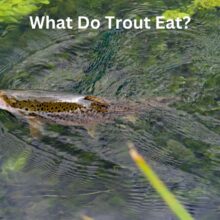
Fishing for trout can be an exciting and rewarding experience, but to be successful, it is important to understand what these fish eat. Knowing what trout eat can help anglers choose the right bait and fishing techniques, increasing their chances of catching a fish.
In this article, we will explore the various types of food that make up a trout’s diet and how understanding these factors can improve your chances of a successful fishing trip.
Understanding the Trout Diet
Trout are opportunistic feeders, meaning they will consume a wide variety of food sources. The primary food sources for trout include aquatic insects, terrestrial insects, small fish, crustaceans, and mollusks.
Understanding the trout’s diet is crucial for successful fishing because it helps anglers choose the right bait and fishing techniques.
Trout are known to feed throughout the day, with the most active feeding periods occurring in the early morning and late afternoon. The type of food they consume will vary based on the time of day, water temperature, and seasonal changes.
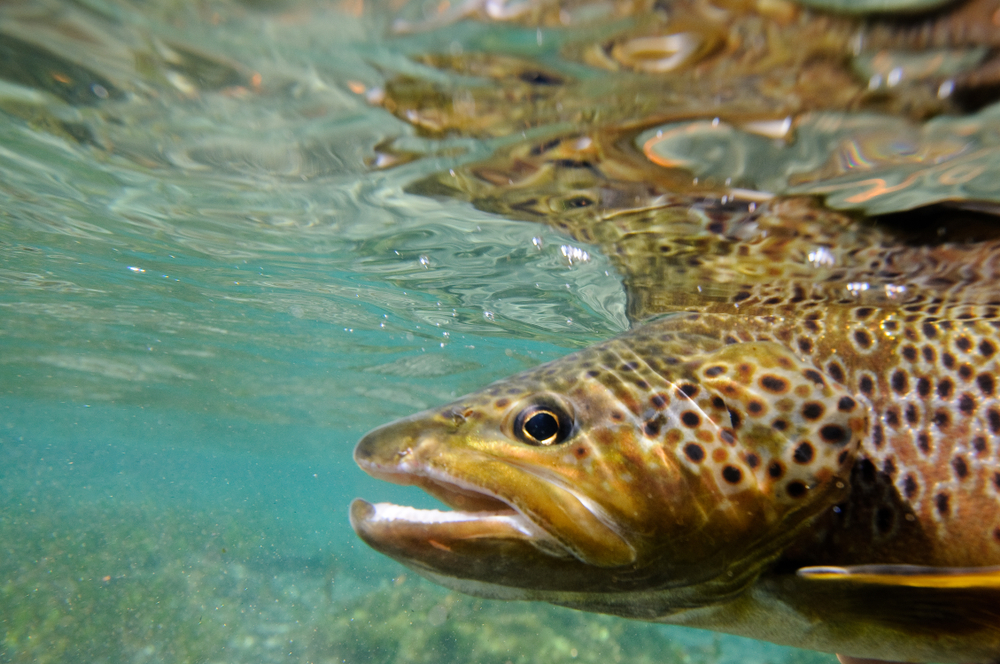
Aquatic insects make up a significant portion of a trout’s diet, and the different stages of an insect’s lifecycle can impact its availability as food for trout. For example, during the spring and summer months, mayflies, caddisflies, and stoneflies are commonly found in the water and make up a significant portion of a trout’s diet.
Terrestrial insects also play a vital role in a trout’s diet, and they are typically found in and around the water’s edge. During the summer months, grasshoppers and beetles are abundant, and these insects can be an excellent source of food for trout.
In addition to insects, small fish, crustaceans, and mollusks can also be found in a trout’s diet. Small fish, such as minnows and fry, are commonly eaten by larger trout. Crustaceans, such as crayfish and shrimp, are also a favorite food source for trout. Mollusks, such as snails, are typically found in slower-moving waters and can be consumed by smaller trout.
Understanding the various types of food that make up a trout’s diet is essential for successful fishing. By knowing what a trout is likely to eat, anglers can choose the right bait and fishing techniques to increase their chances of catching a fish.
Aquatic Insects
Aquatic insects are one of the most significant food sources for trout. These insects can be found in streams, rivers, and lakes, and they make up a large portion of a trout’s diet. Some of the most common aquatic insects that trout consume include mayflies, caddisflies, stoneflies, midges, and dragonflies.
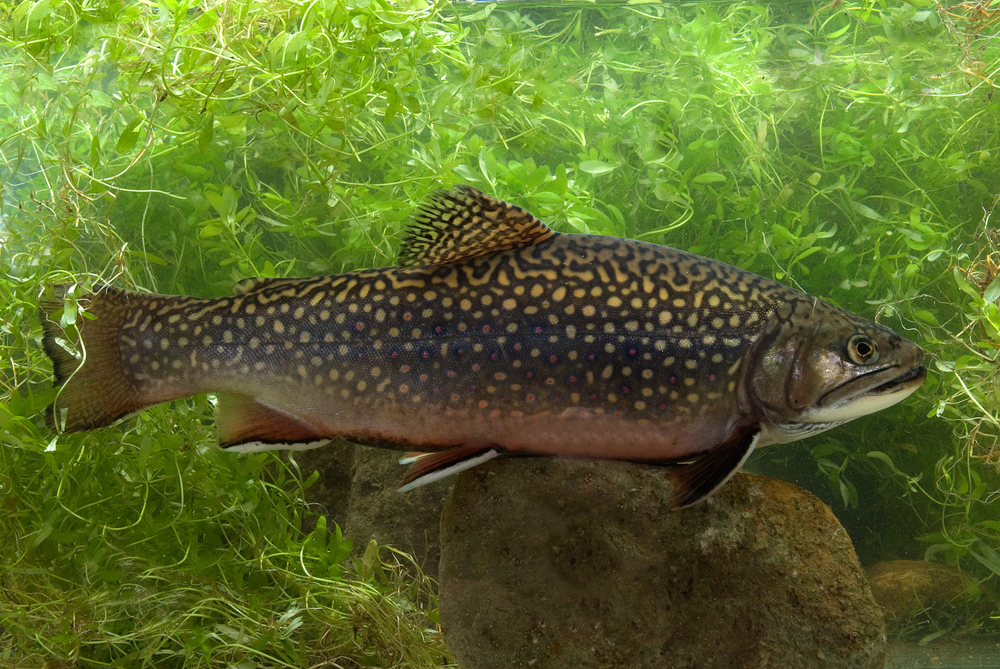
Mayflies are a favorite food source for trout and are typically found in slower-moving water. These insects go through various stages in their lifecycle, including nymph, dun, and spinner, and can be found in the water at different times of the day.
Caddisflies are also commonly consumed by trout and are found in a variety of water conditions. These insects can be found in streams, rivers, and lakes and are most active in the early morning and late afternoon.
Stoneflies are another favorite food source for trout and can be found in fast-moving water. These insects are most active in the spring and early summer months and can be found in both nymph and adult stages.
Midges and dragonflies are also commonly consumed by trout and can be found in a variety of water conditions. Midges are typically small and can be found in the water year-round, while dragonflies are larger and are typically found in larger bodies of water.
Understanding the lifecycle of aquatic insects and when they are most active can be helpful for anglers looking to catch trout. By selecting the right bait and fishing techniques that mimic the natural movement of these insects, anglers can increase their chances of catching a fish.
Terrestrial Insects
Terrestrial insects are insects that live on land but are often found in and around the water’s edge. These insects can be a significant food source for trout, especially during the summer months when they are most abundant. Some of the most common terrestrial insects that trout consume include grasshoppers, ants, beetles, and spiders.
Grasshoppers are one of the most abundant terrestrial insects and are a favorite food source for trout. These insects can be found in and around the water’s edge during the summer months and can be easily caught by trout.
Ants are also commonly consumed by trout and can be found in large numbers during the summer months. These insects are typically small and can be difficult to see in the water, so anglers may need to use smaller baits to mimic their natural movement.
Beetles are another favorite food source for trout and can be found in and around the water’s edge during the summer months. These insects are typically larger than other terrestrial insects and can be easily spotted by trout.
Spiders are also commonly consumed by trout and can be found in and around the water’s edge. These insects are typically smaller than other terrestrial insects and can be challenging to see in the water.
Understanding the types of terrestrial insects that trout consume and when they are most abundant can be helpful for anglers looking to catch fish. By selecting the right bait and fishing techniques that mimic the natural movement of these insects, anglers can increase their chances of catching a fish.
Other Food Sources
In addition to aquatic and terrestrial insects, trout also consume other food sources. These food sources can include small fish, crustaceans, and mollusks.
Small fish, such as minnows and fry, can be found in streams and rivers and are commonly eaten by larger trout. These fish can be caught using lures or bait that mimics their natural movement in the water.
Crustaceans, such as crayfish and shrimp, are also a favorite food source for trout. These animals can be found in and around the water’s edge and can be caught using lures or bait that mimic their natural movement.
Mollusks, such as snails, can also be consumed by trout, especially smaller trout. These animals are typically found in slower-moving waters and can be caught using bait that mimics their natural movement.
Understanding the various types of food sources that trout consume can be helpful for anglers looking to catch fish. By selecting the right bait and fishing techniques that mimic the natural movement of these food sources, anglers can increase their chances of catching a fish.
Factors Affecting Trout Diet
Several factors can impact a trout’s diet, and understanding these factors is essential for successful fishing.
Water temperature is one of the most significant factors that can impact a trout’s diet. As water temperatures change, the types of insects and other food sources available to trout can also change. For example, during the colder months, aquatic insects may not be as active, and trout may switch to other food sources such as small fish or crustaceans.
Time of day can also impact a trout’s diet. Trout are most active during the early morning and late afternoon, and during these times, they may be more likely to consume certain types of food sources, such as aquatic insects.
Seasonal changes can also impact a trout’s diet. During the spring and summer months, there may be more insects and other food sources available to trout, while during the fall and winter months, these food sources may be less abundant.
The type of water body can also impact a trout’s diet. Trout in streams and rivers may consume different types of food sources than those in lakes or ponds.
Understanding these factors can help anglers choose the right bait and fishing techniques to increase their chances of catching a fish.
For example, during the warmer months, anglers may want to use bait that mimics the natural movement of aquatic insects, while during the colder months, they may want to use bait that mimics the movement of small fish or crustaceans. By adapting their fishing techniques to these changing factors, anglers can increase their chances of success.
Conclusion
In conclusion, understanding what trout eat is essential for successful fishing. Trout are opportunistic feeders and consume a wide variety of food sources, including aquatic and terrestrial insects, small fish, crustaceans, and mollusks.
Factors such as water temperature, time of day, seasonal changes, and the type of water body can all impact a trout’s diet, and understanding these factors can help anglers choose the right bait and fishing techniques to increase their chances of catching a fish.
By selecting the right bait and fishing techniques that mimic the natural movement of these food sources, anglers can improve their chances of success and have a more enjoyable fishing experience.
15 Different Types of Trout – (Native, Invasive and Hybrids)
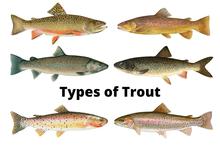
With so many different types of trout it can often be very confusing for the beginner angler.
Even experienced anglers may have difficulty recognizing some of the lesser known trout species.
Trout are freshwater fish species of the genera Oncorhynchus, Salmo, and Salvelinus, all of which belong to the Salmoninae subfamily of the Salmonidae family.
Non-salmon fish with names that incorporate the word trout include Cynoscion nebulosus, spotted seatrout, and speckled trout.
Fun Fact:
Most anglers assume Brown Trout are native but they were actually introduced from Germany in 1883
Types of Trout
- Rainbow Trout
- Brook Trout
- Cutthroat Trout
- Brown Trout
- Lake Trout
- Steelhead
- Tiger Trout
- Dolly Varden Trout
- Splake
- Bull Trout
- Palomino Trout
- Gila Trout
- Golden Trout
- Apache Trout
- Arctic Char
While there are many regional variations of trout we have listed the fifteen most common trout species that you are likely to encounter out in the wild.
Rainbow Trout
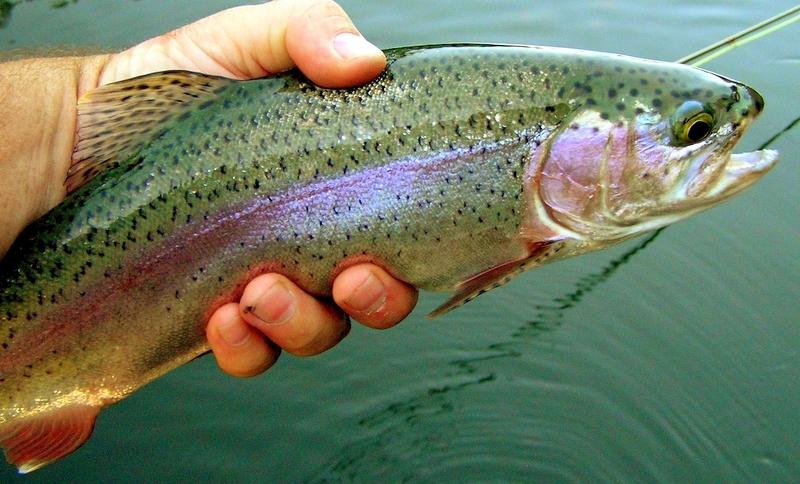
Rainbow trout (Oncorhynchus mykiss) is a salmonid that is found only in cold-water Pacific Ocean rivers in Asia and North America.
Adult rainbow trout weigh between 1 and 5 lb (0.5 and 2.3 kg) in freshwater streams, although lake-dwelling and anadromous species may weigh up to 20 lb (9 kg). Coloration varies widely across subspecies, forms, and environments.
Coloration varies greatly among locations and subspecies. Adult freshwater forms are often blue-green or olive green with strong black spotting along the body.
Adult fish have a broad crimson stripe extending from the gills to the tail, which is particularly noticeable in breeding males.
The caudal fin is squarish with just a few forks. Lake-dwelling and anadromous variants are often silverier in color, with the reddish line nearly totally absent.
Rainbow trout juveniles have parr markings (dark vertical bars) like other salmonid juveniles. Parr markings are frequently preserved in various redband and golden trout varieties until maturity.
Some populations of coastal rainbow trout (O. m. irideus) and Columbia River redband trout (O. m. gairdneri), as well as cutbow hybrids, may have reddish or pink throat markings similar to cutthroat trout.
Fin clips are used in several areas to identify hatchery-bred trout from natural trout. The adipose fin is clipped as a management technique to identify hatchery-reared fish.
Brook Trout
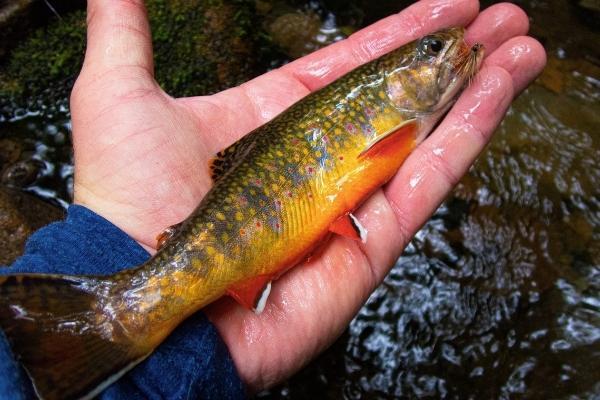
The brook trout (Salvelinus fontinalis) is a freshwater fish species in the Salvelinus genus and the Salmonidae family.
It is indigenous to Eastern North America, including the United States and Canada, but it has been introduced to other regions of the continent, as well as Iceland, Europe, and Asia.
In certain parts of its distribution, it is also known as the eastern brook trout, speckled trout, brook charr, squaretail, brookie, or mud trout.
The brook trout is the state fish of nine states in the United States: Michigan, New Hampshire, New Jersey, New York, North Carolina, Pennsylvania, Vermont, Virginia, and West Virginia, as well as Nova Scotia’s Provincial Fish.
The brook trout is dark green to brown in color, with a distinctive marbled pattern of lighter colours along the flanks and back, extending at least to the dorsal fin and, in some instances, all the way to the tail.
There is a noticeable dispersion of red dots surrounded by blue halos around the sides. The belly and lower fins are red in color, with white leading edges. When the fish are spawning, their bellies become brilliant red or orange, particularly the males.
Cutthroat Trout
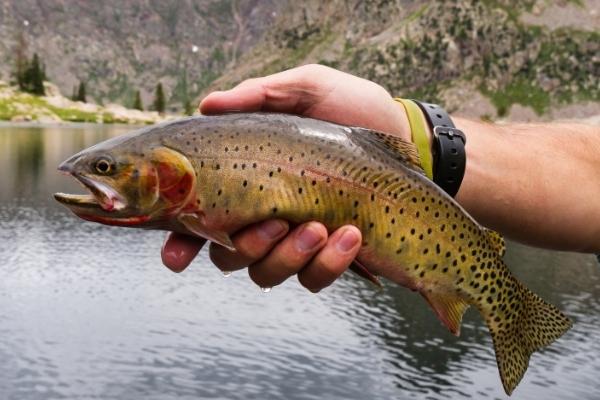
The cutthroat trout (Oncorhynchus clarkii) is a salmonid fish species found only in cold-water rivers in North America’s Pacific Ocean, Rocky Mountains, and Great Basin.
As a member of the genus Oncorhynchus, it is a Pacific trout, which includes the globally distributed rainbow trout. Cutthroat trout are a popular gamefish, especially for fly fishers.
The common name “cutthroat” refers to the conspicuous red color on the lower jaw.
Cutthroat trout tend to live and spawn in small to medium-sized, clean, well-oxygenated, shallow rivers with gravel bottoms. Unlike most trout when spawning the prefer to do so in in clean, cold, and rather deep lakes.
They are native to alluvial or freestone streams that are frequent tributaries of rivers in the Pacific, Great, and Rocky Mountains. Cutthroat trout spawn in the spring and may unintentionally but naturally hybridize with rainbow trout, producing viable cutbows.
Many subspecies of cutthroat trout are now classified as threatened in their natural ranges due to habitat degradation and the invasion of non-native species. Two subspecies, O. c. alvordensis and O. c. macdonaldi, are thought to be extinct.
Cutthroat trout are raised in hatcheries to help restore populations in their natural ranges and to provide non-native lake settings for fishing. Cutthroat trout and several subspecies have been selected as the official state fish of seven western U.S. states.
Brown Trout
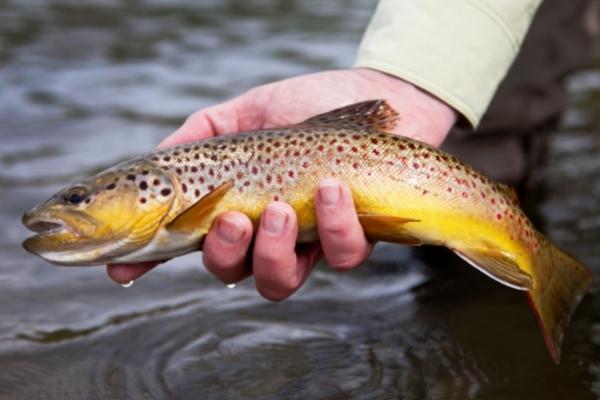
Brown trout (Salmo trutta) is a salmonid fish native to Europe that has been widely introduced into suitable environments across the globe.
Although considered an invasive species of trout in the United States it has been so well accepted as a be considered a true wild trout.
A thin, reddish-brown body with a long, narrow head are distinguishing features.
Freshwater brown trout varies in color from completely silver with few spots and a white belly to the more well-known brassy brown cast with medium-sized spots encircled by lighter halos on the fish’s belly. The more silver forms, the more likely they are to be mistaken for rainbow trout.
The brown trout is a medium-sized fish that may reach a mature weight of 1.0 kilogram (2.2 lb) or less and a length of around 100 cm (39 in) in certain areas. However, in many smaller rivers, a mature weight of 1.0 kg (2.2 lb) or less is usual.
It is made up of entirely freshwater populations known as the riverine ecotype, Salmo trutta morpha fario, a lacustrine ecotype known as lake trout, and anadromous forms known as sea trout, S. trutta morpha trutta.
The latter spends the most of its life in the sea, only returning to fresh water to spawn.
Sea trout are known by a number of names in Ireland and the United Kingdom, including sewin in Wales, finnock in Scotland, peal in the West Country, mort in North West England, and white trout in Ireland.
Lake Trout
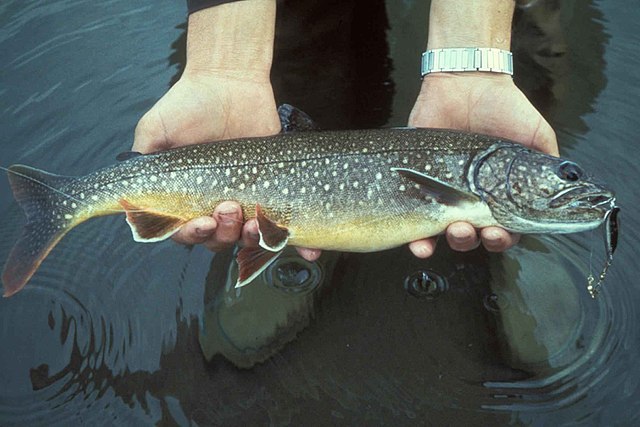
Lake trout (Salvelinus namaycush) is a freshwater char that mostly inhabits lakes in northern North America. Other names for it include mackinaw, namaycush, lake char (or charr), touladi, togue, and grey trout.
In Lake Superior, it is also known as siscowet, paperbelly, and lean. Lake trout is prized as a game fish as well as a food species. Those caught with dark coloration are known as mud chickens.
Lake trout have a rather small range. They can only be found in northern North America, mostly in Canada, but also in Alaska and, to a lesser extent, the northeastern United States.
Lake trout have been widely introduced into non-native streams across North America and many other parts of the world, mostly in Europe, but also in South America and parts of Asia.
Lake trout are the largest of the chars, with a record weight of more than 102 pounds (46 kg) (netted) and a length of 50 inches (130 cm), and fish exceeding 15–40 pounds (6.8–18.1 kg) are common. The standard length ranges from 24 to 36 inches (61 and 91 cm).
According to the IGFA, the largest caught on a rod and reel was 72 pounds (33 kg), taken in Great Bear Lake in 1995 and measuring 59 inches in length (150 cm).
Steelhead
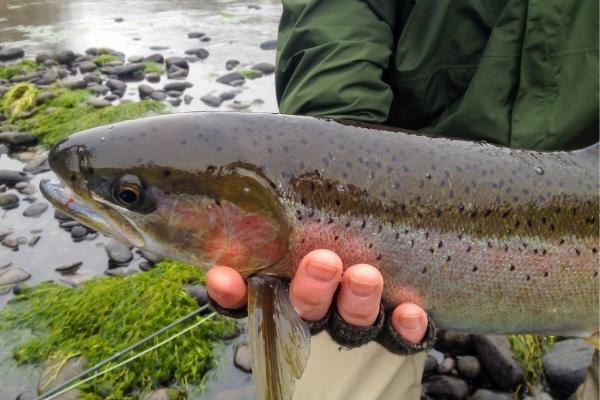
Steelhead, often known as steelhead trout, is the anadromous variant of the coastal rainbow trout (Oncorhynchus m. irideus) or redband trout (O. m. gairdneri) that returns to fresh water to reproduce after spending two to three years in the ocean.
Steelhead are endemic to the Pacific basin’s cold-water streams in Northeast Asia and North America.
Steelhead, like other sea-run trout and salmon, spawn in freshwater, smolts move to the ocean for several years of foraging, and adults return to their natal streams to spawn. Steelhead are iteroparous(breed several times in their life), yet survival rates range from 10 to 20 percent.
Freshwater rainbow trout, often known as steelhead, have been introduced into the Great Lakes and travel into rivers to spawn. Commercially propagated steelhead are known as Ocean Trout in Tasmania.
Tiger Trout
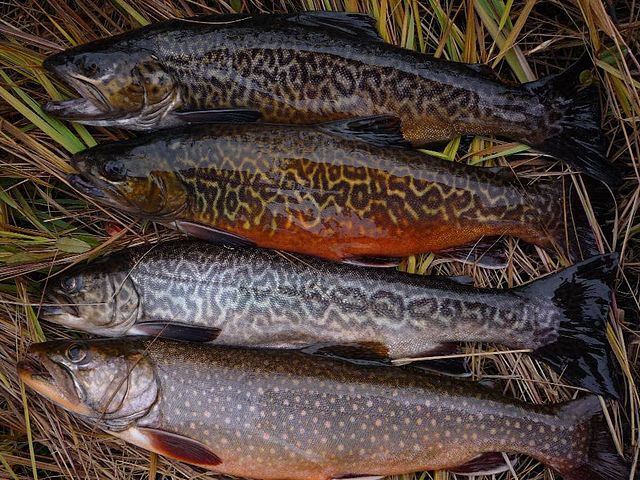
The Tiger trout (Salmo trutta Salvelinus fontinalis) is a sterile intergeneric hybrid of brown and brook trout (Salmo trutta Salvelinus fontinalis) (Salvelinus fontinalis). The term is derived from the strong vermiculations that resemble tiger stripes.
In the wild, the fish is an outlier, with brook trout having 84 chromosomes and brown trout having 80. Records show incidences as far back as 1944. The cross is distinct in that the parents are from different genera.
Tiger trout may be produced on a constant basis in hatcheries. This is performed by fertilizing brown trout eggs with brook trout milt and then shocking them with heat, resulting in the production of an extra set of chromosomes and increasing survival rates from 5% to 85%.
Tiger trout are claimed to develop faster than native species, however this is not widely agreed upon, and they have been introduced for sport fishing on a regular basis.
Dolly Varden Trout
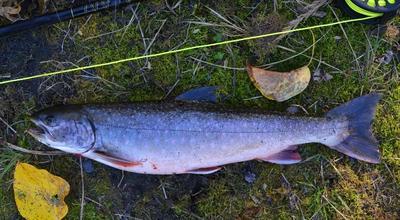
The Dolly Varden trout (Salvelinus malma) is a salmonid fish found only in cold-water rivers of the Pacific Ocean in Asia and North America. It belongs to the genus Salvelinus, which includes 51 species, the most prominent of which are the brook, lake, and bull trout, as well as the Arctic char.
The two subspecies of Dolly Varden found in North America are the Northern Dolly Varden (S. m. malma) of the Arctic drainages and the Southern Dolly Varden (S. m. lordi) of the Pacific drainages. These might potentially be identified as separate mitochondrial lineages.
Splake

The splake (Salvelinus namaycush x Salvelinus fontinalis) is a fish hybrid that was formed by crossing a male brook trout (Salvelinus fontinalis) with a female lake trout (Salvelinus namaycush).
The name is a hybrid of speckled trout (another name for brook trout) and lake trout, and it was perhaps used to designate such hybrids as early as the 1880s.
Male lake trout-female brook trout hybrids (called “brookinaws”) have also been bred, but have not been as successful.
Bull Trout
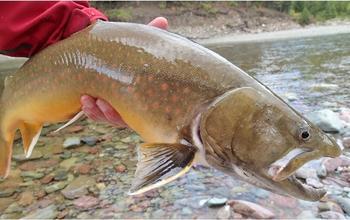
The bull trout (Salvelinus confluentus) is a salmonid char that is only found in northern North America. S. confluentus, formerly known as the “Dolly Varden” (S. malma), was reclassified as a separate species in 1980. Bull trout are listed as an endangered species under the United States Endangered Species Act (1998).
The fins of a bull trout, like those of other char species, have white leading edges. Its name comes from its unusually large head and mouth for a salmonid. Bull trout may grow to reach 103 cm (41 in) long and 14.5 kg in weight (32 lb).
Bull trout may be migratory, moving over vast river systems, lakes, and the ocean, or resident, living their whole lives in the same stream.
Migratory bull trout are much larger than resident bull trout, which seldom exceed more than 2 kg (4.4 lb).
Bull trout are distinguished from brook trout (S. fontinalis) by the absence of noticeable spots on the dorsal fin as well as yellow, orange, or salmon-colored patches on the back, as are red markings with blue halos on the brook trout. The tail fin of a bull trout is not as forked as that of a lake trout.
Tiger trout are claimed to develop faster than native species, however this is not widely agreed upon, and they have been introduced for sport fishing on a regular basis.
Palomino Trout
Golden rainbow trout, often known as palomino trout, are developed from a single mutant color variation of O. mykiss that was discovered in a West Virginia fish hatchery in 1955.
The golden rainbow trout is mostly yellowish, with no usual green field or black dots but a diffuse red stripe.
The palomino trout is a cross between a golden and a common rainbow trout, resulting in a hue that is somewhere in the middle.
The golden rainbow trout is not the same as the naturally occurring O. m. aguabonita, often known as the Kern River golden trout of California.
Gila Trout
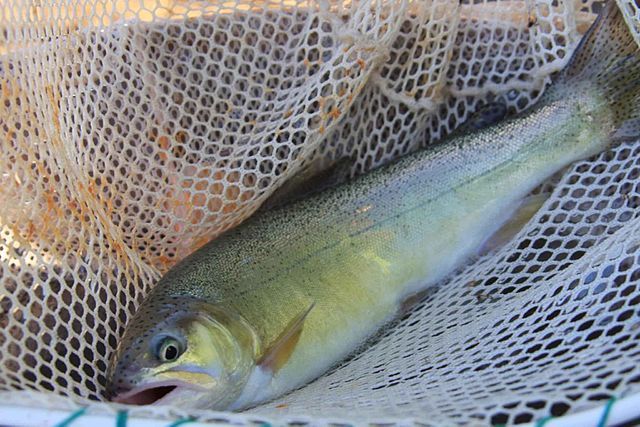
The Gila trout (Oncorhynchus gilae) is a salmonid species endemic to the Southwest United States that is related to the rainbow trout. Prior to 2006, the Gila trout was categorized as endangered by the federal government.
The Gila trout was downlisted to threatened in July 2006, after extensive effort by the Game and Fish departments of New Mexico and Arizona, as well as the US Forest Service and the US Fish and Wildlife Service.
By the time the Gila trout was restricted to fishing in the 1950s, its numbers and range had been decreased and reduced to the point that the copper-colored trout just wasn’t available to fishermen. As of 2011, this fish may be caught in both states.
The Gila trout is endemic to the Gila River’s tributaries in Arizona and New Mexico. The Gila trout has traditionally been found in Arizona’s Verde and Agua Fria drainages.
The body of a Gila trout is yellow with black markings. The average overall length is about 30 cm (11.8 in), while the highest total length is around 55 cm (21.7 in).
Gila trout and Apache trout are closely related. Apache trout, on the other hand, might have a spot behind and in front of the pupil (eye) as well as large visible spots on the body, while Gila trout have several little black spots on the top half of the body.
Golden Trout
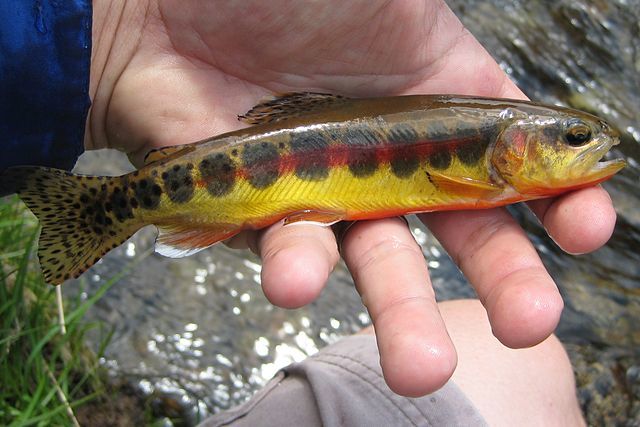
The Golden Trout (Oncorhynchus aguabonita or Oncorhynchus mykiss aguabonita) is a species of trout endemic to California.
The Golden Trout Creek (tributary to the Kern River), Volcano Creek (tributary to the Golden Trout Creek), and the South Fork Kern River are the most common places to find the golden trout. Since 1947, the Golden trout has served as California’s official freshwater state fish.
The California golden trout is connected to two subspecies of rainbow trout. The Little Kern golden trout (O. m. whitei), which lives in the Little Kern River basin, and the Kern River rainbow trout (O. m. gilberti), which lives in the Kern River system. These three fish, when combined, comprise what is known as the “golden trout complex.”
The golden trout was originally characterized as a subspecies of the salmon species, with the name Salmo mykiss aguabonita, and it is still sometimes considered a subspecies (now named Oncorhynchus mykiss aguabonita), along with numerous other rainbow trout subspecies generally known as redband trout.
The golden trout has golden flanks with red horizontal stripes along the lateral lines and around 10 black, vertical, oval markings (called “parr marks”) on each side. The leading margins of the dorsal, lateral, and anal fins are white. Adults in their natural environment are 6 to 12 inches (15 to 30 cm) length. Large fish are those that measure more than 12 inches (30 cm). Golden trout transplanted to lakes have grown to weigh up to 11 pounds (5.0 kg).
The golden rainbow trout, commonly known as the palomino trout, should be differentiated from the similarly called golden rainbow trout. The golden rainbow trout is a rainbow trout color variation.
The golden trout is endemic to California’s southern Sierra Nevada highlands and may be found at altitudes ranging from 6,890 feet (2,100 m) to 10,000 feet (3,000 m). Outside of its native California habitat, Golden trout are more often seen in cirques and rivers in wilderness areas at elevations of 10,500–12,000 feet.
Apache Trout
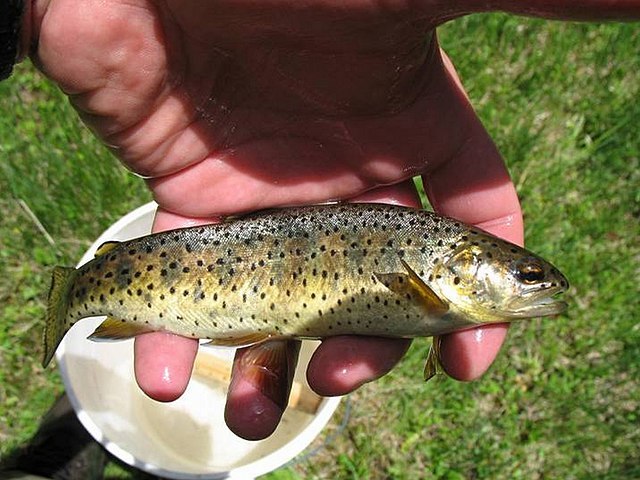
Oncorhynchus apache is a freshwater fish species of the salmon family (family Salmonidae) in the order Salmoniformes. It belongs to the Pacific trout family.
The Apache trout is Arizona’s state fish and one of just two trout species endemic to the state, the other being the gila trout (O. g. gilae).
It is endemic to clean, chilly streams in the White Mountains that run through coniferous woods and marshes, but it has been imported into numerous local lakes.
The Apache trout is found in the upper Salt River basin (Black and White rivers) as well as the upper Little Colorado River watershed. Apache trout have been introduced into isolated streams in the Pinaleno Mountains and the Grand Canyon’s North Rim that are outside of their traditional habitat.
The Apache trout measures 6–24 in (15–61 cm) in length and weighs 0.4–6 lb (0.2–2.7 kg). It seldom surpasses 10 in (25 cm), although in its native, headwater streams, it may grow up to 16 in (40 cm).
Apache trout are yellowish-gold in color with a golden belly and medium-sized black patches that extend beyond the lateral line and onto the dorsal and tail fins.
The top of its head and back are dark olive in color, and two little black spots on each side of the pupil give the illusion of a black stripe/mask through each of its eyes. A neck mark, varying in hue from yellow to gold, may appear below the lower jaw.
Arctic Char
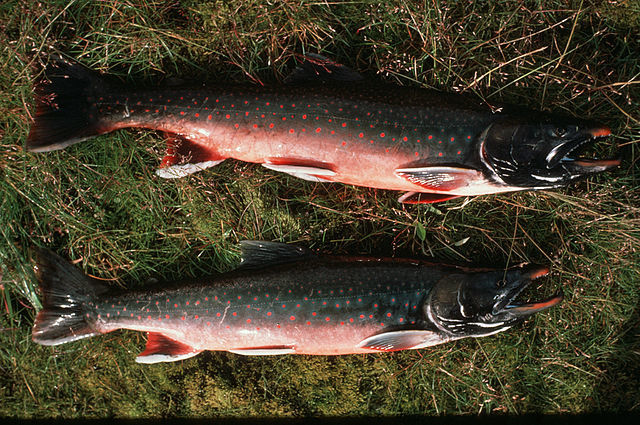
The Arctic char (Salvelinus alpinus) is a cold-water fish in the Salmonidae family that is endemic to alpine lakes and arctic and subarctic coastal seas. It is found in the circumpolar north.
It spawns in freshwater, and populations may be lacustrine, riverine, or anadromous, meaning they return from the ocean to spawn in the rivers where they were born.
No other freshwater fish species can be found thus far north; for example, it is the sole fish species in Lake Hazen on Ellesmere Island in the Canadian Arctic. It is one of the rarest fish species in the United Kingdom and Ireland, found mostly in deep, cold glacial lakes, and is threatened by acidification.
It is significantly more common and heavily fished in other regions of its range, such as the Nordic nations. It is known as golets (Russian: олe) in Siberia, and it has been introduced in lakes where it sometimes threatens less resilient native species, such as the small-mouth char and the long-finned char in Elgygytgyn Lake.
The Arctic char is related to both salmon and lake trout and has many traits with both. The color of the fish varies greatly depending on the time of year and the natural conditions of the lake where it dwells.
The look of Arctic char varies depending on population. The dorsal side of the Arctic char is black, while the ventral side is a mix of red, yellow, and white.
Night Fishing for Trout
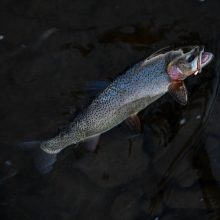
Late summer begins a special time for brown trout. As the temperature cools and gives way to crisp autumn air, brown trout prepare their annual spawning rituals, swimming into headwaters and creeks in droves.
In mid-October, female brown trout will search out shallow gravel bars and other areas that are deemed suitable for bedding areas where they will lay their eggs.
But before this happens, both male and female browns will congregate in large schools in or near the creeks where they will spawn.
While in these groups, brown trout are highly aggressive and will strike at nearly anything within range as they intend to fatten themselves up for the spawn, when they often go without food for long stretches.
Also Read: When do Trout Spawn?
One of the best strategies for catching trophy brown trout before the spawn is to go under the cover of darkness. Night fishing for trout is quite popular in areas where brown trout rule the rivers.
Many night time trout fishing techniques will work for rainbows as well as browns as night fishing is a popular activity for anglers during the summer months.
If you’re planning to venture out after sundown, here are a few tips to help you target these big browns—and other kinds of trout—and hone in your skills to become an expert when it comes to night fishing for trout.
Best Times for Night Fishing for Trout
It’s a well-known fact among trout anglers that these kinds of fish have acute vision, even in the darkness of night. Trout use their eyesight and other senses to seek out and attack prey after sundown, but their behavior is relatively the same when it comes to the night time feeding patterns of trout.
Trout are very active at dusk and even for a few hours after dark. This is widely considered to be one of the best times for catching trout after dark.
Larger lake trout will cruise the banks after dark in search of potential meals, and areas where streams come into a lake are particularly good for catching trout at night.
It’s also good to fish for trout right before daylight in many cases as the soft glow of the rising sun provides just enough light for trout to begin hunting the shallows and other areas for a morning bite.
Lighting Conditions
Contrary to popular belief, fishing for trout at night when the full moon is shining bright is actually not the best time to catch trout. Similar to their daytime behavior, trout will usually become more active when there is significant cloud cover at night, which allows them to have an added level of stealth over any unsuspecting prey.
It’s best to fish in areas where there is no artificial lighting as this allows trout to feed as they naturally would in the dark. Simply put, the darker the night, the better your chances of catching trout.
Best Baits for Nighttime Trout Fishing
Trout usually pick up on potential meals using their eyesight, but that’s going to be limited when they are feeding under the cover of darkness. Baits that appeal to other senses besides eyesight often work best for trout fishing at night.
Many anglers opt for a stick bait or broke-back minnow that will break the water’s surface and catch the attention of any nearby trout. These can be fished using a steady retrieve, or brought in using a sporadic motion in the same way a wounded baitfish might behave.
Glow-in-the-dark worms and grubs are always a unique choice that sometimes produce results. Using a light-up bobber is also a good way to keep a close eye on your lure so you won’t miss any bites.
Also Read: Best Trout Spinning Reel
Cut baits and other natural options are also a solid choice for night fishing. Trout will often use their sense of smell to detect certain things that can satisfy their hunger.
Using a trout bobber with cut bait is a popular choice at night because it allows anglers to sit and wait patiently without spooking trout away from a good location.
Nightcrawlers are another great choice for night fishing trout and can be fished using a bobber, or with a split-shot sinker to keep the bait at or near the bottom.
Night Fishing Gear
You’ll need to bring some kind of headlamp or other light in order to see when fishing for trout at night. As we’ve already mentioned, it’s best to avoid exposing trout to any artificial light if possible, but that’s often unavoidable, especially when it’s particularly dark.
Also Read: Best Trout Spinning Rod
Using a headlamp or other light that offers a red is your best choice. Red-colored lighting is not as noticeable to trout and is often enough for anglers to see their surroundings well enough to tie on lures and do other tasks without alarming any nearby trout.
If you must use a typical headlamp or flashlight, be sure to use it sparingly in order to avoid scaring away any attentive fish.
Best Tactics for Nighttime Trout
- For lake trout, be sure to keep your bait or lure in the strike zone as long as possible. This means you’ll want to cast out almost parallel to the bank instead of casting your lure straight out into the lake.
- While daytime trout fishing might focus on deep pockets and fishing around structure, trout often like to venture far into the shallows at night in search of small baitfish and other critters. Don’t be afraid to cast into the shallows, especially near areas where streams enter into a lake.
- When night fishing for trout, you’ll want to tune your ears in as much as you can since many anglers say that you’ll hear a bite before you ever see or feel one.
Conclusion
Night fishing has many similarities to daytime angling, but can sometimes produce surprising results. If you use these tips and stick with a stealthy approach, you’ll find that it’s just as easy to catch a trophy trout at night as it is during the daytime.
How to Catch Trout for Beginners
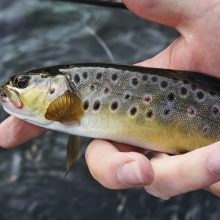
Trout fishing is one of the most popular forms of fishing in the world, but it requires a very unique approach in order to truly be successful.
Some of the most popular game fish species in North America are relatively easy to catch. Simply place a worm on your hook, throw it into the water and wait.
Trout fishing, on the other hand, requires a bit more effort and determination.
Targeting a fish that’s more elusive is part of why so many anglers love trout fishing. But don’t let this new challenge discourage you from embarking on your first trout fishing trip. Here are some of the best trout fishing tips for beginners that will help you get started.
Trout Fishing
There are six major trout species that are native to the North American continent. Each of these fish are known to be ferocious fighters who thrive in cool, clear water—which is why trout can usually be found hidden away in mountain streams, deep into the wilderness.
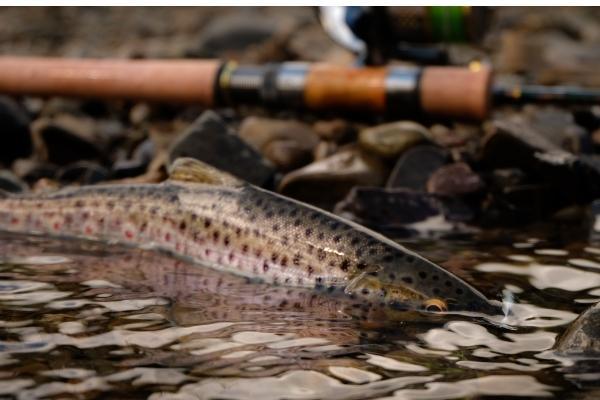
Trout have exceptionally good eyesight compared to other game fish species. Their keen eyesight, coupled with their usual habitat of crystal clear water means that they can usually spot when something doesn’t appear to be natural. Other fish rely more heavily on smell to detect prey, but trout rely heavily on their vision.
Trout can also be very picky eaters, passing up other meals that most fish would devour without a second thought.
They usually feed on just about any kind of natural insect or other critter that makes its way into the water.
Flies and insects are a favorite cuisine, so most trout anglers will opt to use artificial flies and small worms or crickets as bait.
These fish are also fun to catch because of their reputation for fighting hard once they’ve been hooked. Even a small trout can require a surprising amount of effort to land.
Their bodies are long and slender, which gives them the ability to swim fast and hard in short bursts instead of slowly pulling on the line like other game fish species.
Where to Catch Trout?
This is one of those trout fishing tips that may vary depending on the particular geographical location you’re in. Some trout can be found in lakes, but the vast majority of trout are found in rivers and streams.
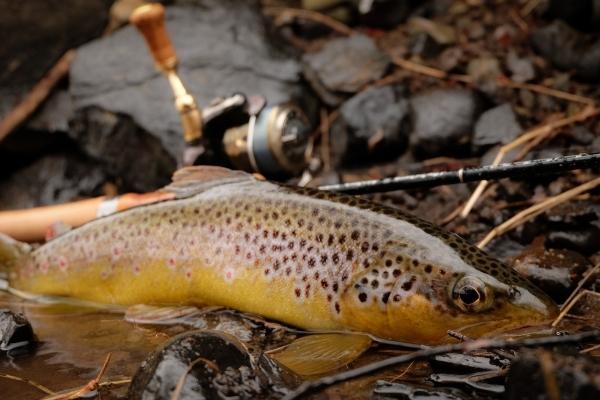
Trout can sometimes be naturally-occurring in certain areas, or stocked by wildlife management organizations.
- Stocked trout – are known to be fairly easy to catch as they have been raised to eat whatever comes their way without having to worry about many predators.
- Wild trout – however, are highly cautious and much more skittish than their tame cousins.
Trout like to stay in fast-moving water that is well-oxygenated. Look for rough spots in the water, or places where there are small “rapids” as these are more likely to be home to small minnow and are ideal locations for trout to hangout.
Sometimes, trout will congregate in runs where the river becomes more narrow and deep.
- Runs – are great to fish as trout usually have a harder time spotting approaching predators due to the increased depth.
- Pools – or sections of creeks and streams where the water has slowed down and deepened, are another great location for this reason.
Trout also love to stay in or around bends in a creek or river as this is a great spot for them to set up and have a good vantage point for any potential meals floating downstream.
Also, look for trout in areas where two streams intersect or meet as this will provide ample oxygen and better chances that they’ll find food.
What to use to catch trout?
When it comes to the best trout fishing setup, most beginner anglers are encouraged to use a lightweight or ultralight spinning reel combo.
These are simple to use and require a lot less time to learn and become familiar with than a fly rod.
A good choice spinning reel for trout would be a size 2000 reel that you would pair with a trout rod of roughly 6 feet in length with an ultralight power rating and a fast action.
Remember, trout have great eyesight, so you’ll want to use a lighter fishing line that they won’t be able to see underwater.
It’s usually recommended to use fluorocarbon line that’s between 4 and 8 pound test. Anything heavier than 8 pound test line will probably be visible to trout and they are very unlikely to bite your lure or bait.
What kind of bait or lure should I use?
Artificial baits are very effective for trout, but it’s recommended that beginners start with some kind of smaller live bait when they first start.
Using live bait doesn’t require you to do anything more than cast your bait into the water and let the current carry it down to the specific location where trout are hanging out.
Wax worms, crickets, nightcrawlers and even small minnows are often great choices for trout fishing. Don’t use an oversized hook as this will once again put you in danger of being spotted by a trout. Using a size 8-12 hook is usually best for beginner trout anglers.
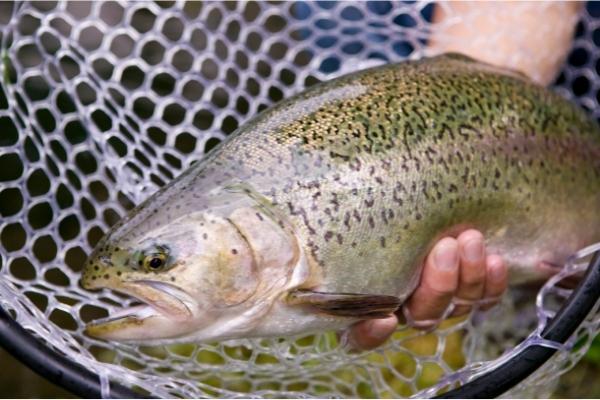
Artificial lures also work very well for trout fishing. These might require just a bit more experience to understand just how to use them, but knowing when and where to use a specific kind of bait will lead to catching more fish.
A rooster tail is a great artificial trout lure as the small, rotating spoon will catch the attention of any nearby trout. In-line spinners, or small and slender minnows and jerkbaits are also great choices for trout lures that will work in a variety of different circumstances.
How to Catch Trout
There are a variety of different ways to catch trout, with some methods working better in certain parts of the country.
For beginners, there are three basic trout fishing methods that are easy to learn and will allow you to catch fish more quickly than other methods.
1. Bottom fishing
This method is the easiest trout fishing method and is often used by seasoned anglers when the water is slow-moving and the fish are having trouble biting. Live bait is often the best choice for bottom fishing, but some artificial baits will also be productive.
Anglers will want to throw their bait into the water and allow it to sink to the bottom. It’s very important to keep your line tight and let your bait remain as still as possible to avoid spooking any fish that come to investigate.
Watch your line and pay attention to small bumps as this usually indicates that a trout is biting your hook.
2. Drifting
This method of trout fishing lets you use the water’s current to carry your bait to the right spot. Drifting typically requires a certain amount of patience as many anglers might become tired of constantly reeling in and throwing into the same spot over and over.
The key here is to cast your bait upstream from the point where you expect the trout to be and allow your bait to float in the current without interfering in it’s course. You’ll want to keep an eye on your bait when drift fishing, and it can sometimes be hard not to lose sight of your lure, especially in strong currents.
3. Bobber Fishing
This method is wildly popular with most other common game fish species like crappie, bass and bream. Simply rig your bobber about a foot above your lure (depending on the water’s depth) and cast it into the area where you expect trout to be staging.
Be sure to use a small bobber that won’t be easily noticed by trout. The key to bobber fishing for trout is to watch your bobber closely. Trout can sometimes bite your hook without ever pulling the bobber under. If you think you’re getting a bit, gently pull up on your rod to check and make sure a trout hasn’t taken your bait.
There are many different kinds of baits you can use when bobber fishing for trout and this is a great way to introduce youngsters to the sport.
When to Fish for Trout
Spring is considered to be the best time of the year for trout fishing, especially for beginners. Cold weather makes trout lethargic, but warmer temperatures will mean warmer water and more active trout.
Another reason why trout love springtime is that an abundance of bugs and insects will emerge from their winter hideouts, meaning trout see spring as a time to feed and recover from a long, hard winter.
Trout fishing in the spring can often be hit or miss due to weather fluctuations. Watch the forecast and wait for a prolonged warming period to move in as this will be the best time for trout fishing.
Summer is also great for trout fishing as there will be plenty of food for trout. Be aware that when hot temperatures move in, trout will usually feed less, making them very difficult to catch.
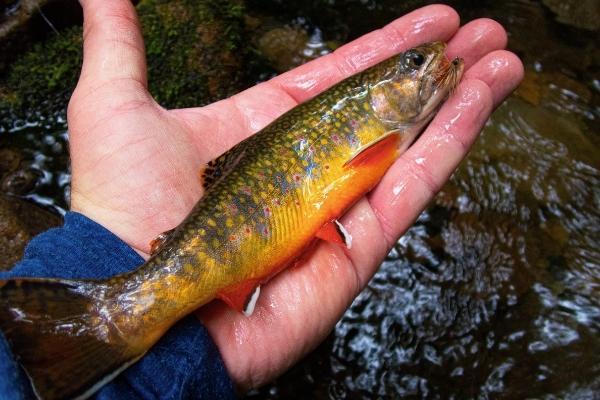
The autumn season is often good for trout fishing early on as newer, cooler temperatures are met with enthusiasm from trout who will become more active when the temperature drops. However, the closer it gets to winter, the less active trout will be.
Winter is not a great time to go trout fishing, but that doesn’t mean that you can’t catch them during the colder months.
Only the most dedicated anglers fish for trout in the winter, but it is a good time to avoid the spring and summer crowds while enjoying the beauty of nature.
For some southern states, winter is an ideal time for trout fishing because temperatures may not dip down near the freezing mark long enough to discourage the fish from feeding regularly.
How to Handle Trout
Be very careful with any trout that you do catch because the slightest injury can easily kill the fish. Trout are made for the water and the longer they are on dry land means their chances of survival are decreasing.
Most anglers who practice catch and release with trout will never take them fully out of the water. Instead, they will get a hand on the trout while it is still in the water and gently remove the hook.
If you want to snap a quick photo, simply lift the trout out of the water and make it quick. Have your camera ready before taking the trout out of the water.
Trout can be especially slippery, but it’s crucial to not squeeze them very hard as this will undoubtedly cause internal damage and lead to death. Be sure to follow the advice of the experts when it comes to safely handling and releasing trout. Learning how to revive a trout before fully releasing it is also another step that will go a long way to ensure its survival.
Trout Fishing Rules and Regulations
It’s very important that you become familiar with all the laws and regulations pertaining to trout in the specific area you plan to fish.
For some states, an angler only needs to purchase a fishing license in order to legally trout fish. But in other states, anglers must purchase a fishing license, as well as a trout stamp or specialized trout fishing license.
Be sure to research and ask about any trout fishing guidelines that should be followed in the place you plan to fish.
Many states have laws against using certain kinds of bait, while some areas have outlawed the use of barbed hooks. Following the rules is essential as this ensures that everyone can safely enjoy trout fishing for many years to come.
Conclusion
We hope these trout fishing tips tips for beginners will be helpful to everyone who is interested in learning more about one of North America’s greatest game fish species.
Trout fishing might seem tough at times, but taking a careful and thorough approach will eventually lead to success.
Once you’ve mastered the tips included in this guide, you’ll be ready to share your own bits of wisdom with newcomers and help others to catch trout!
Bobber Fishing for Trout
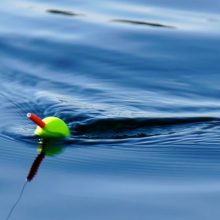
Bobber fishing for trout can be highly productive, and is a great option for those looking to keep things simple and catch fish in a way that isn’t too complicated.
Bobbers have been used for hundreds of years and are thought to have first originated in Norway when anglers would use them on a single fishing line, or to hold up a net.
When one mentions trout fishing, people likely imagine a picturesque scene in which an angler—clad in waders and the proverbial fly-fishing hat—casts his fly rod gracefully above the rolling river, hoping for a bite.
It may come as a surprise to some anglers, but trout can actually be caught using one of the most basic and commonly-used fishing rigs known by fishermen across the world: a bobber, sinker and hook.
Bobber Fishing for Trout
Using a bobber is widely considered to be the least complicated way to catch just about any kind of fish species across the world.
It’s easy enough that a child can understand and learn to rig their own bobber-style fishing setup.
Using a bobber to catch trout is a great way for beginner anglers to learn where to find trout and observe their behavior without having to focus too much of their attention on what kind of tackle they are using.
Anyone who has done much trout fishing knows that this particular species has incredibly good vision and can be spooked by the slightest mistake on the part of the fisherman.
Using a line that’s too thick, or a lure that does not appear to be natural is almost certainly going to make it tough to catch trout.
However, by carefully setting up your bobber-rig and knowing just how and where to use it, you can catch a limit with a bobber setup with very little difficulty.
Bobber Setup
One of the most important keys to having a successful bobber-style rig for trout revolves around properly setting up your bobber, sinker and hook. Here’s what you’ll need:
- Light rod and spinning reel (ultralight combos work best)
- A ¾” or 1” size bobber (make sure your bobber is large enough to hold the weight of your sinker, hook and bait)
- 4 or 6 pound test monofilament line
- Hooks (6 and smaller are ideal for trout)
- Small, split-shot sinkers (anything too large will be seen by trout)
- Bait (this can vary based the type of trout you’re fishing for or the area)
Most fishing for trout with floats will be done on light tackle. So that means a good spinning rod with an ultralight power rating and a high quality spinning reel in a size 2000 or 2500.
How to Rig your Bobber Setup for Trout Fishing
After properly setting up your rod and reel with the fishing line you’ve chosen, you’ll then want to tie on your hook using a simple Fisherman’s knot or Palomar knot.
Most of the commonly-used fishing knots will work for a bobber setup. The most important thing to keep in mind is that the knot is small and tight.
Next, you’ll want to place a split shot sinker roughly one foot above your hook. The distance between your hook and sinker might vary is you’re fishing a particularly shallow stream or pond.
If you plan to fish in water less than 2 feet deep, it’s a good idea to place your sinker about 8 inches above the hook. Pay attention to your sinker before every cast because it can sometimes slide or move up and down the line.
Finally, place your bobber an equal distance away from your sinker from your hook. For instance, if you have your sinker one foot above your hook, you’ll want to place your bobber one foot above the sinker.
It’s important that you don’t have your sinker too close to the hook as this could spook any trout that notices a small ball of lead dangling in the water above their next meal.
What’s the Best Bait to Use when Bobber Fishing for Trout in Small Streams and Ponds?
Trout are not quite as picky as you might expect when it comes to what they’ll bite. However, you might need to try a variety of different baits in order to determine just what the trout in your local stream or pond are after.
Natural Baits
Trout love to feast on natural food like crickets, worms, salmon eggs, and other things they usually find floating around their habitat. Natural baits are often preferred by anglers who target trout with bobber setups because these kinds of baits will appeal to their natural predatory senses.
- Worms – be sure to hook your worm directly in the middle of its body and let the current wave the worm’s upper and lower end in a way that looks natural. Curling the worm around your hook might work, but trout are exceptionally good at noticing something that doesn’t look right. Any type of mealworms and grubs should also be hooked in the same manner.
- Crickets or grasshoppers – trout will not hesitate to feast on any cricket or grasshopper that is unfortunate enough to find its way into ponds or streams. Hook your crickets through the back in order to help camouflage the hook and entice any hungry trout.
- Salmon eggs, corn kernels, etc. – for any kind of bait like this, you’ll simply want to cover the end of your hook with them. Don’t run the hook completely through your bait as trout will notice this and likely be turned away.
- Shrimp or crawfish – These work wonders for trout located in streams and rivers because a live crawfish floating in the current is a hearty meal that might as well have a neon sign above it. Pay attention to properly hook the shrimp or crawfish in a way that hides your hook.
Artificial Lures
Despite their keen senses of sight and smell, trout will actually fall for an artificial bait at times. Companies like Berkley make a very popular “trout worm” that can be rigged (wacky) the same way you’d hook a real worm for trout fishing.
Other lures that anglers have reported as being successful are grubs, jigs, flies and small minnow-like plastic lures.
How and Where to Fish a Bobber for Trout
Bobber fishing for trout in small ponds and streams requires an understanding of how trout behave in each type of habitat. The techniques that work in a small stream likely won’t produce fish in a lake or pond.
Do your research and become familiar with where to find trout in the particular spot you plan to fish.
Small Rivers and Streams
Trout can be found in rivers and streams in many different parts of the world. They tend to prefer colder water, so you’re more likely to find trout in streams that are located in high-elevation areas.
Trout will typically face upstream and wait for their prey to float down toward them. They will often hide behind structures or rocks in an effort to stay hidden and ambush anything they plan to eat.
When using a bobber setup to fish for trout in streams and rivers, you’ll want to carefully sneak in and cast your lure above the area where you expect the trout to be staging.
Let it slowly float downstream and then hold steady while waiting for trout to come investigate, and hopefully bite your hook. Try not to move your line too much as this will spook any trout who are within sight of the bait or bobber.
Lakes and Ponds
Using a bobber to fish for trout in lakes and ponds is a lot like the techniques you’ll use for rivers and streams, but you won’t have to worry about fighting the current as much.
Remember, trout prefer colder water, so they’ll typically hang out in deeper water and temporarily make a trip to the shallows in search of a meal.
Try to find an area where shallow water is in close proximity to deep water. Look for a spot with plenty of small baitfish and cast your lure into the water.
You might have to try a number of different spots and angles at the particular lake or pond you’re fishing at in order to find the best location for hooking a trout.
Catch and Release
If you stick to these tips, you’ll be catching trout in no time using a simple bobber-style rig. Just be sure to check your hook, sinker and bobber each time you cast in order to make sure they are the proper distance apart and that your bait is hooked in the right way. We hope you enjoyed this article and find it useful!
Best Trout Spinning Reel 2023 – [Buyer’s Guide]
![Best Trout Spinning Reel 2023 - [Buyer’s Guide] trout reels](https://www.lakeontariooutdoors.com/wp-content/uploads/2020/01/best-trout-spinning-reel-220x220.png)
Fishing for trout in small rivers and streams requires a more finesse style setup than when trolling or fishing on really large rivers.
The best spinning reels for trout will usually be sized in a 1000 up to a 2500. It is very rare to use anything larger.
The majority of trout fishing will be done on an ultralight setup. To be able to cast light spinners or bait rigs you need to have a matching rod, reel and line that is suitable for casting smaller weights.
- Rod – ultralight power rating, fast action 6 to 7 feet
- Reel – size 1000 to 2500
- Line – 4 to 8 pound monofilament
The above ranges should be seen as a guide for how most trout anglers would go about putting together a decent trout combo.
If you are bouncing a night crawler downstream using light line like 4 pound mono really does need a decent spinning reel in a size 1000 or maybe a 2000.
But;
Throwing a chunky Kastmaster spoon on size 8 lb line then a size 2000 or 2500 reel would be more appropriate.
A high quality reel from the big name brands makes a great investment and should last years of use if you look after it properly.
A high quality spinning reel is an investment, rods will come and go but a good reel if looked after should last at least ten years of use.
Best Trout Spinning Reels
1. Abu Garcia Revo SX
The Revo SX is the top trout reel available. You get super smooth high end performance at a low to mid range price point.
Casting with very light lines is where the Revo shines. Line falls off the spool with very little friction, meaning longer and much more accurate casts.
The Revo’s stand out feature is it’s line management system.
A combination of the Everlast bail system and it’s Rocket Spool lip allows line to fly off the reel even when trying to cast very light lures.
The Everlast bail system lays line down in an almost perfectly even pattern across the spool even when you are reeling back in the line under heavy pressure.
Uneven line lay can result in bunching and low/high spots of the previous layers of line. When this happens the chances of the next layer getting bed down into the bottom layers is increased.
When line gets caught in lower layers like this it can have a massive negative effect on casting performance.
The Rocket spool is specifically designed to allow line to run over it with the minimum amount of friction.
The body is super rigid and made from a carbon composite material called C6 with the frame being made from X-Craft alloy for reduced flex under load.
A size 20(Abu Garcia’s version of 2000) makes trout spinning reel, loaded with 6 lbs monofilament and you can cast light lures and bait rigs/bobbers with ease.
Specifications:
- Rocket Spool Lip
- Everlast bail system
- 8 stainless steel ball bearings
- Carbon Matrix drag system
- Super rigid housing/body
2. Pflueger President
If you are on a budget or this is your first reel then the President spinning reel from Pflueger has built a solid reputation as a great value spinning reel.
Boasting no less than 7 stainless steel bearings it puts some other high end reel to shame in terms of how smoothly it operates.
Pair one of these with an Ugly Stick Elite spinning rod and you have your self a pretty decent trout combo for under 100.
It has a braid ready spool so you can run braid on it without any backing required.
It comes with a host of features that are normally found in much more expensive reels.
A multi-disc drag system, sealed drag washers and a really light body make for a really good first reel.
Specifications:
- Braid ready spool
- Great low price point
- 7 stainles steel ball bearings
3. Shimano Stradic HG
Shimano have a number of models in the Stradic range with the Ci4+ being not only the most expensive but also the one crammed full of it’s top technology.
The Stradic HG however, gives you access to a wealth of those features without the high end price.
All Stradic reels use a cold forging process called Hagen that results in both the internal gears and the body being super stiff.
Lower warp and better stiffness means the alignment of the internal gears run super smooth with reduced wear and tear.
Nothing screams “I’m a cheap reel” more than there being lots of flex in the body.
With the Stradic line of trout reels you can be sure you are buying the very best of technology and quality.
The HG is virtually identical to the Ci4+ except that it is slightly heavier. The HG uses a Hagene body whereas the Ci4+ shaves off a small bit of weight from the use of a carbon infused material CI.
For the money the HG offers much better value than the more expensive Ci4+ and most anglers will barely notice the slightly lighter weight of the Ci4+ for it to make a difference.
Specifications:
- Propulsion line management system
- Hagen gear and body
- 6 ball bearings
- Cold Forged aluminum spool
4. Shimano Sedona
The Sedona sits somewhere in the middle between the Stradic HG and the Pflueger President in terms of price.
As you would expect it is a step up from the President in terms of quality.
This is the third incarnation of the Sedona model over the past ten years.
The Sedona FI replaces the much loved FE and FD models.
With the newer FI model you actually get the same build process, materials and quality that is found in the Stradic line, namely Hagane cold forging.
The cold forged Hagane internal gears are stronger and lighter than the equivalent machine cut gears.
It also has increased gear ratio’s(except for the 1000) and an upgrade to the drag power over previous models.
You also get the propulsion line management system as found in the Stradic’s for a more even line lay on the spool.
The spools are machine cut double anodized and come in a beautiful gold tint.
There is also a reduction in weight over previous models. The reel also has it’s center of gravity sitting closer to the rod thanks to a new design called G Free.
You get a host of some of Shimano’s best reel technolgy without paying the premium prices.
Specifications:
- Hagene gears
- Magnumlite rotor design
- Double anodized machine cut spool
- Propulsion line management
5. Pflueger Supreme XT
The Supreme XT is Pfluegers offering in the mid-range market.
It is a step up in terms of quality and performance from the President line that we featured earlier.
It is far from being a repackaged President however, and is a very solid reel in it’s own right.
Although not really aimed a lighter spinning setups there is a size 2500 available and if you are working long stretches of bigger rivers then that extra size is definitely advisable.
A big wide spool helps line fly out when casting and also reduces coiling as monofilament line can be prone to having quite a bit of memory.
A silky smooth set of no less than ten ball bearings make for a very solid retrieval system and the drag housing is really well sealed.
Specifications:
- 10 stainless steel ball bearings
- Sealed carbon drag
- Magnesium body and rotor
6. Penn Clash
Penn have built some of the most loved reels particularly in the bigger offshore segment but they also do a mean line of spinning reels.
The clash is normally considered a saltwater spinning reel but in a size 2000 can make an excellent trout reel.
These reels if properly maintained will last decades. They are built for the harsher environment that salt water creates so the seals on the drag and reel housing are second to none.
A full metal body and heavy duty aluminum bail arm scream quality. The internal gears are CNC machined for extreme accuracy and provide a very tight and accurate knit which makes the Clash feel very smooth during operation especially under high loads.
A set of HT-100 carbon fiber drag washers maintain a very smooth drag that does not buckle under pressure regardless of how it is set.
Not the lightest reel in this list but almost bullet proof in terms of durability and longevity.
Specifications:
- HT-100 carbon fiber drag
- Leveline line management
- 8 sealed stainless steel bearings
7. Shimano Stradic Ci4+
If money were no object then the Stradic Ci4+ is the top choice light weight spinning setups.
It is regarded as one of the bet performing spinning reels ever built.
Aimed at the upper end of the freshwater spinning reel market you get all of Shimano’s very best technology and materials rolled into one reel.
Although it is the most expensive trout reel in this list it really does beat out all other competitors in terms of performance.
You will never use a reel that runs as smooth as a Stradic Ci4+. It is built using Shimano’s new CI Carbon Infused technology that makes the reel casing twenty percent lighter and one and a half times stronger than conventional methods.
A lighter stronger spinning reel for trout is always going to make your trout rod feel more balanced than a heavier one making all day casting less of a chore.
Specifications:
- Carbon Infused built process
- Hagene cut gears
- Extremely well sealed
Trout Reels
Buying a good trout reel from the start will actually save you money in the long run.
Spinning rods come and go and of all of the component of your trout setup the rod will most likely to be the first to break.
Rod tips get broken all the time, but reels are a different story.
A goof spinning reel for trout should last 10 years if you look after it properly and get it serviced every few years.
Given the option I would rather spend the bulk of my budget on a high quality spinning reel.
What Size Spinning Reel for Trout ?
When choosing a trout reel the first main decision to make will be just what size reel will you need.
As a general guide most spinning reels for trout fishing will fall into the 1000 to 2500 size range.
A lighter size 1000 would generally be considered to run well with some pretty light fishing line. Monofilament in the 2 to 6 lb breaking strain range.
At the upper end of the scale a size 2500 will run best on 6 lb up to 10 lb. That means roughly 200 yards of 6 pound line and 120 of the bigger 10 pound line.
Smaller trout fishing lures will generally perform better when using the lightest line possible.
It all depends on how big the body of water you will be fishing the most is. Really small rivers and streams you could well be using a 6 foot rod and a size 1000 reel.
This will allow you to throw really small lures up close. A bigger river might demand a beefier reel and rod with heavier line.
Gearing
The internal component of a reel are it’s beating heart and the quality of the gears and bearings are what a great reel differ from a junk reel.
There are plenty of cheap reels available that are built to a low standard. Spend any kind of time using one of these and it will become quickly apparent that they are not really fit for purpose.
Cheap internal gears will warp and flex when put under any king of pressure. Helical cut gears and those that are machined from high quality metals are the only things that you should be concerning yourself with.
Spool
The quality of a spool is often one of the most over looked components on a fishing reel.
A good casting reel will have a wide spool arbor and a lip design that helps to reduce as much friction as possible.
Fishing line, especially monofilament has a memory and if it is tightly wound onto a small spool it can become very coiled which results in a lot of knots and shorter casting distances.
That being said size 1000 spinning reels have such a small spool that the you will invariably get some amount of coiling of your line.
Also Read: Types of Trout
This is rarely an issue if you are getting a lot of use out of your reel but if it is stored for months on end be prepared for some coils to form.
They will generally work themselves out over time with regular use.
The lip of a spool needs to be a smooth as possible to allow the line to run freely over it.
How the line is laid on the spool as you retrieve it will also have a massive impact on your casting performance.
Badly laid line will tend to bunch up at certain points which eventually results in it bedding down into the previous layers.
Drag
The drag setting on a reel is one of the first things to break if it is not properly sealed.
Even the most careful angler will eventually put their rod and reel down on the ground on the banks of a river.
Grit, sand and dust can be the end of the drag on a reel if it is not properly sealed. Once any kind of grit makes it’s way into the drag then it is very likely to seize up.
A seized drag when you have a fish on the line will generally result in a snapped line and lost trout.
Luckily enough smaller trout will not put a massive amount of pressure on the drag of your reel assuming you have a good reel from a respected manufacturer.
All of the best trout reels have a high quality drag that is well sealed and can take a lot of pressure.
Trout Fishing Setup for Beginners
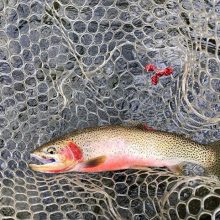
If you are new to trout fishing or have decided to take your kids to a local stream that is known to contain trout then you might not be aware of what kind of trout fishing setup you will need.
Most people fishing for trout on rivers or streams will be targeting fish that are roughly 3-4 lbs or under.
Although that may sound small, trout can give a very spirited fight and pound for pond are one of the most exciting freshwater fish you can catch on light gear.
Trout Fishing Setup
A good all round setup for catching trout will be an ultralight spinning combo. The ultralight is basically what is known as the power rating of the rod and the size of the spinning reel.
Look for a setup with the following attributes:
- Rod – ultralight power, fast action, length 5’5″ to 6′
- Reel – size 2500 spinning reel
- Line – monofilament of roughly 6 to 8 lbs breaking strain
This type of trout fishing setup will cover you for most small rivers, streams and small lakes.
Also Read: Catching Trout at Night
You can reliably land fish up to roughly 10 lbs in weight on this kind of tackle but you’ll end up having to give them a lot of line before they tire which isn’t ideal.
Rod
Smaller waters definitely require a shorter rod. Using a rod that is 7′ or more in length can become extremely cumbersome as the extra foot or so of rod will be less maneuverable in and around large bushes and bank side trees.
A smaller rod is also better when playing smaller fish as you have a bit more control when using the shorter length.
Look for a 6’6″ rod as this gives you a bot more versatility than something as short as 5’6″.
The kind of rod should be a spinning rod as they perform better in terms of casting when compared to a baitcasting setup.
Baitcasters really shine when you need to cast medium and heavy weight lures.
But when it comes to lighter lures or using a bait rig then it is the spinning setup that really shines.
The best trout spinning rod will have an ultralight power rating. This rods are built to run best with light lines in the 2 to 8 lbs breaking strain range.
Lighter rods have much more feedback and pairing a heavy rod with light line would be a disaster as the rod would not allow you to feel what was going on with your lighter terminal tackle.
Reel
A small trout spinning reel in the 1000 to 2500 size range will be the best option to pair with the rod above.
These smaller reels are designed to use light lines and have a small drag setting on them that is suitable for trout fishing.
A good reel needs to be serviced regularly and always make sure that you keep your reel free from grit or sand.
One of the most common mistakes to to leave your rod on the ground with the reel in the dirt.
Over time sand and dirt will get into the reel housing and damage the gears and the drag washers so always be careful when placing you gear on the ground.
Line
Monofilament is the line of choice when using such small small tackle.
Mono has a lot more stretch in it than braid as this can help to act as a shock absorber for small trout when striking.
It also casts much better when used on a spinning reel in smaller breaking strains than braid.
Of all of your trout fishing gear and tackle make sure to regularly inspect your line so that there is no defects or abrasion marks on it.
Failing to do so can end up in a snapped line just as you hook a fish.
Lures
The best trout lures are generally small and will imitate what the trout are naturally feeding on. Small spinners such as a Rooster tail for trout and Rapala’s imitate minnows and other small bait fish that trout absolutely love.
When looking to imitate smaller sub-aquatic insects such as larvae you an use a small trout jig in either a black or chartreuse color used in the tail.
Bobbers, Hooks and Bait
When using bait for trout you will need to use a single hook.
If you are practicing catch and release then always make sure to use a barb-less hook. Barb-less hooks make de-hooking much easier and you are less likely to injure a fish.
If you cannot get a barb-less hook you can take a pliers to a normal barbed hook and flatten the barb using the pliers.
A size #8 or #10 single hook is best when fishing for small trout.
A simple trout bobber can be anything from a wine cork to a smaller store bought option.
Bait can be anything from nightcrawlers to Powerbait or even sweetcorn. It is best to experiment and see just what exactly they are biting on.
Trout Fishing Gear and Tackle
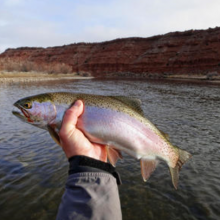
Trout fishing is one of the most accessible forms of fishing if you are just starting out or are looking to introduce a child to their first time out fishing.
Trout are pretty widespread, with both natural and stocked waters being available in almost every state.
Whether that’s a small river or on a stocked lake the type of trout fishing gear you will need is pretty simple.
Trout offer great sport and can be caught on some very simple and inexpensive tackle
For the majority of trout anglers a lightweight spinning setup(technically referred to as an ultralight setup) is going to the best option.
At a quick glance the following trout fishing gear is what the most would use especially for small brown and rainbow trout that weight less than 4 lbs:
- Rod – Ultralight spinning rod, roughly 6 feet in length with a fast action
- Reel – A 1000 or 2000 size spinning reel
- Line – Monofilament fishing line from 2 to 8 pounds
Trout Fishing Gear List
1. Rod
When fishing with light tackle a spinning rod will be the better option when compared to a casting rod.
Spinning rods are paired with spinning reels. A spinning reel is much better at casting light tackle than a baitcaster reel.
Light lures and rigs need a rod that is also light. Using a heavy rod will be a disaster.
You won’t get any decent casting distance and the rod will be far too heavy to give you any kind of feedback.
Sensitivity is key, the best trout fishing rods will have an ultralight power rating and have a fast action.
- Rod Power – Rod power describes how heavy a lure or line weight a rod is rated for. An ultralight rod is suitable for very light lures and line that is between 2 and 10 pounds breaking strain.
- Rod Action – Rod action defines where on the rod blank the rod will start to bend naturally once pressure is applied to it. A fast action will start to bend higher up closest to the rod tip. A slow action will bend lower down towards the reel seat.
- Rod Length – A shorter rod is better for use on smaller rivers and streams were casting distance is not much of a concern. They also give you better control of the fish at landing time.
Throwing small lures requires a fast action. This means the rod tip bends higher up on the rod blank. It also means a lot more sensitivity is translated from the line back into the rod.
You need to be able to detect soft bites and to be able to set the hook quickly, a fast action rod is the bet choice for this.
2. Reel
As stated above when using a spinning rod it needs to be paired with a spinning reel. A good trout spinning reel will be roughly a size 1000 or 2000. On a larger river you may need a size 2500 for the extra line capacity.
- Reel Type – A spinning reel is the number on go to type of reel for trout fishing. They are easy to cast and are better than a baitcaster when using light weight trout fishing gear.
- Reel Size – Spinning reels that fall in the range of between 1000 and 2500. For very small rivers a size 1000 is fine and it should be able to hold 100 yards of 4 lb monofilament fishing line. A size 2500 is suitable for much larger rivers and should be able to hold 100 yards of 8 lb mono.
- Materials – Cheaper reels will be made from graphite. If you are looking to buy a quality reel then aim for a reel that has as much metal as possible used in it’s construction. Carbon drag washers and a well sealed body and gearing system is preferable too.
Most small reels for the big brands such as Shimano, Abu Garcia, Pflueger and Daiwa will all be suitable.
Look to invest in a quality reel as if they are well looked after they should easily last 10 years.
3. Line
Monofilament is the number one choice when fishing for trout on light gear. It is easy to know and casts well with lighter lures.
It also floats which can be an advantage and is virtually invisible when compared to braided fishing line.
It is also quite cheap and modern monofilament is quite durable and can take quite a few knocks and scrapes before it needs snaps.
Mono does suffer from having a large memory so if you leave it on a reel with a small diameter spool for a long period of time it can become coiled.
4. Bobbers, Hooks and Weights
Bobber can be as simple as a wine bottle cork with a slit in it to run the line through or the can be store bought models that can be tuned to vary how high or low the bobber or float sits in the water.
If you are introducing kids to fishing then bobber fishing for trout can be one of the most fun ways to introduce them to fishing.
Most trout fishing hooks will be single hooks. If you are using a light bait rig with some powerbait or a night crawler on it then a single hook is the best choice.
Treble hooks are usually reserved for use on lures rather than when using bait.
Split shot weights are usually the better option when trout fishing. You can simply pinch them on lightly with a pliers and fine tune how deep you line and hook will run quite easily.
5. Lures
The best trout lures will usually be small spinners and spoons. Trout love to chase a small spinner and the flash and vibration that they give off is what attracts them to them.
Classic spinners like the Rooster Tail and Panther Martin are none to be super reliable when fishing across deeper pools in rivers.
The Kastmaster and Acme Little Cleo are some of the bests small spoons that you can use.
Most trout setups will be able to fish both small lures and bobber rigs so you shouldn’t need an extra rod or reel.
6. Net
A fishing net although not crucial definitely makes life easier when you are trying to land a small trout.
They are also a lot easier on the fish. If you are practicing catch and release then you will want to handle the trout as little as possible.
Modern trout nets are made with a soft rubber mesh. Older style knotted string mesh is rarely used anymore as it can cause a lot of damage to small delicate fish.
Best PowerBait for Trout
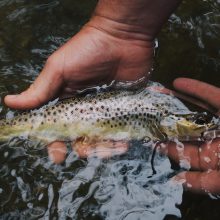
If you ever looked around a tackle shop and seen small jars of brightly colored dough then you may be confused as to how you might go about choosing one to use.
Choosing the best PowerBait for trout will depend on a number of factors:
- Type of water you are fishing
- Light and weather
- Stocked or wild fish
- Time of year
PowerBait is made by Berkeley and over the past few decades they have continually refined both ingredients and the scent that goes into making it.
Originally there was just the now famous PowerBait dough. Down through the years the range has evolved to include a number of other offerings – Dough, Salmon Eggs and Trout Nuggets.
They are available in a large range of colors so you should be able to match the light conditions with one of the options.
Best PowerBait for Trout
Like most things in fishing opinions vary as to what is the best PowerBait for trout. Look at any fisherman’s tackle box and you will see one guy favors the more natural looking colors whereas another will swear by the brighter artificial colors.
Unfortunately there are no hard and fast rules when it comes to choosing which PowerBait you use.
What works one day may not work the next. Every water is different and you’ll need to experiment.
1. Berkley PowerBait Dough
Power Bait Dough is probably the best PowerBait for stocked trout. Freshly stocked rainbow trout absolutely love it.
As the name suggests it is a dough like substance which means it can be molded onto your hook with ease.
Berkley have released a small plastic mold that will give you a perfectly formed ball every time if you don’t want to do it by hand.
As it is scented it will leave a slight odor on your hands so using the mold is one way to avoid this.
PowerBait can be used with very light gear. You can use nothing more than a hook and small lead weight to help cast and keep it on or near the bottom.
Bouncing a small piece down a river where trout are feeding on salmon eggs can be almost as productive of using natural salmon eggs without all the mess.
It will keep for quite a few months once opened. However, if it does start to dry out it will be all but useless.
Overtime it will also loose it’s scent. Once this happens you are better off binning it and buying a replacement.
2. PowerBait Eggs
As stated above you can form the regular dough into an egg shape, but Berkley actually produce there own line of preformed eggs.
Traditionally salmon eggs were collected by hand. In recent years they have been widely available to purchase in bait and tackle shops.
These artificial eggs are even more convenient and have a pretty decent shelf life. The also come with the standard Berkley scent.
These eggs will float so you need to take that into account with how you fish and rig them.
Personally I use a small split shot about a foot or two from the hook depending on the depth of the river.
You can then bounce them downstream just like a real salmon egg would. The small weight will bounce down the river bottom whilst the egg will stay naturally suspended about a foot or two from the bottom.
3. Trout Nuggets
The Berkley Trout Nuggets are an almost identical match for the type of feed that trout are fed in a hatchery.
They even have a specific color called “Hatchery”. The nuggets are a slightly large more square shape than the eggs just like the specific pellets that hatchery owners use.
You can fish this just like the normal dough on light gear. A pretty simple setup is to thread one onto a small trout hook and cast it out without using weight.
You’ll find that rainbows will hit these on the surface providing you keep yourself as hidden as possible on the river bank.
The are not that effective for will brown trout and you might be better of sticking to the more popular trout lures for rivers and streams in that scenario.
Best Color Powerbait for Trout
If you are fishing for rainbows that are new into the river or lake then you will want to use a bait that is as close as possible to what they were fed on in the hatchery.
Berkley Powerbait Hatchery Pellet Dough is an almost exact match for the pellets that a lot of trout are reared on before they are released into the wild.
If the river has salmon that are spawning in it every year then a red or orange color PowerBait is best used during that spawning season.
On smaller ponds and lakes I have found that chartreuse presented in a very natural way is one of the better colors to use.
Fishing With PowerBait
Just like fishing with any other kind of bait the most important aspect of fishing with PowerBait is to make sure that your presentation of the bait looks as natural as possible even for something so artificial as PowerBait.
Drifting PowerBait is one of the better ways to work it in a river or stream.
Try to only use a small weight that is heavy enough to keep the bait down but light enough to allow it to bounce down the river bottom using the natural power of the water flow.
Always start from downstream of where you think the trout may be naturally hiding. Casting from below them means the are less likely to be spooked and it also allows the bait to run towards you.
If it is moving downstream towards you then it will look a lot more natural.
On lakes you may need a heavier weight depending on how far you need to cast to get where the trout are usually holding.
Bobber fishing with a float for trout is another option to use on small ponds as it gives you the best possible visual feedback.
PowerBait Setup
When using a small piece of PowerBait for trout you’ll need to use the right kind of tackle.
A heavy spinning or baitcasting setup is too be avoided. The best setup is an trout spinning rod and reel combo that is rated for light line.
The rod should be between 6 and 7 feet in length depending on the type of water you are fishing. A longer rod will give you a longer casting distance but on smaller waters it will become more awkward to use.
So size your rod accordingly to the venue you intend to fish on.
You’ll need an ultralight power rating and a fast action. The fast action gives you a much higher starting point for where the rod bends on the blank. This type of action is excellent for casting light lures and getting lots of feedback through the rod helping to detect the smallest of bites.
A good trout reel choice for the rod above is a size 1000 up to roughly a 2500 spinning reel. These smaller reels are great for casting light lines and should be well matched in terms of weight to an ultralight rod.
The go to fishing line choice will be monofilament. For very light setups you can use a 2 lb line and at the heavier end of the spectrum you can go up to 6 lb.







